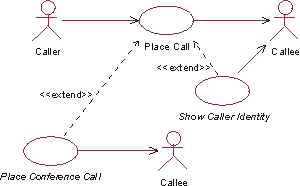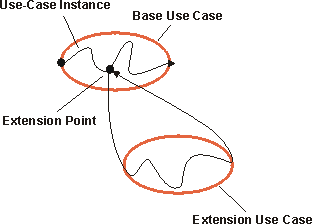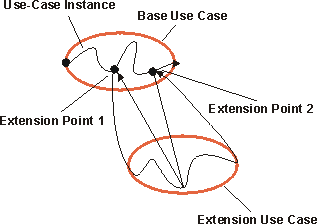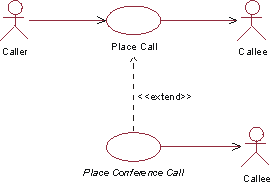| Guideline: Extend-Relationship |
 |
|
| Related Elements |
|---|
ExplanationThe extend-relationship connects an extension use case to a base use case. You define where in the base to insert the extension by referring to extension points in the base use case (see Guideline: Use Case, the discussion on extension points). The extension use case is often abstract, but does not have to be. You can use the extensions for several purposes:
The extension is conditional, which means its execution is dependent on what has happened while executing the base use case. The base use case does not control the conditions for the execution of the extension - the conditions are described within the extend-relationship. The extension use case may access and modify attributes of the base use case. The base use case, however, cannot see the extensions and may not access their attributes. The base use case is implicitly modified by the extensions. You can also say that the base use case defines a modular framework into which extensions can be added, but the base does not have any visibility of the specific extensions. The base use case should be complete in and of itself, meaning that it should be understandable and meaningful without any references to the extensions. However, the base use case is not independent of the extensions, since it cannot be executed without the possibility of following the extensions. Example:
The use cases Place Conference Call and Show Caller Identity are both extensions to the base use case Place Call. In a phone system, the primary service provided to the users is represented by the use case Place Call. Examples of optional services are:
We can represent the behaviors needed for these optional services as extension use cases to the base use case Place Call. This is a correct use of the extend-relationship: since Place Call is meaningful in itself, you do not need to read the descriptions of the extension use cases to understand the primary purpose of the base use case, and the extensions use cases have optional character. If both the base use case and the "base plus extension" use case must be explicitly instantiable, or if you want the addition to modify behavior in the base use case, you should use use-case-generalization instead (see Work Product Guideline: Use-Case-Generalization). The extension use case can consist of one or more insertion segments, each of which may have alternative paths built into it. These insertion segments incrementally modify the behavior of the base use case. Each insertion segment in an extension use case can be inserted at a separate location in the base use case. This means that the extend-relationship has a list of references to extension points, equal in number to the number of insertion segments in the extension use case. Each extension point must be defined in the base use case. One base use case consist of several extend-relationships, which means a use case instance can follow more than one extension during its lifetime. One extension use case may extend into several base use cases, but this does not imply any dependency between the base use cases. There may even be multiple extend-relationships between the same extension use case and base use case, provided the extension is inserted at different locations in the base. This means the different extend-relationships need to refer to different extension points in the base use case. An extension use case may itself be the base in an extend-, include-, or generalization-relationship. For example, this means extension use cases can extend other extension use cases in a nested manner. Executing the ExtensionWhen a use-case instance performing the base use case reaches a location in the base use case where an extension point has been defined, the condition on the corresponding extend-relationship is evaluated. If the condition is true or if it is absent, the use-case instance will follow the extension (or the insertion segment within it that corresponds to the extension point). If the condition of the extend-relationship is false, the extension is not executed. The extension use case may, just like any use case, have a basic flow of events and alternative flows of events (see Guideline: Use Case, the discussion on structure of flow of events). Which exact path the use-case instance will take through the extension depends on what has happened before in the execution (the state of the use-case instance) and also what happens in interaction with actors as the extension is executed. Once the use-case instance has performed the extension, the use-case instance resumes executing the base use case at the point where it left off.
A use-case instance following a base use case and its extension. An extension use case can have more than one insertion segment, each related to its own extension point in the base use case. If this is the case, the use-case instance will resume the base use case and continue to the next extension point specified in the extend-relationship. At that point it will execute the next insertion segment of the extension use case. This is repeated until the last insertion segment has been executed. Note that the condition for the extend-relationship is checked at the first extension point only - if the condition is true, the use-case instance must perform all insertion segments.
A use-case instance following a base use case and an extension use case, the latter with two insertion segments. The multiplicity of the extend-relationship will constrain the number of repetitions of the entire extension that may occur. Note that it is the entire extension that is repeated (and limited by the multiplicity), not just one insertion segment.
Documenting the
Extend-Relationship
|
© Copyright IBM Corp. 1987, 2006. All Rights Reserved. |



